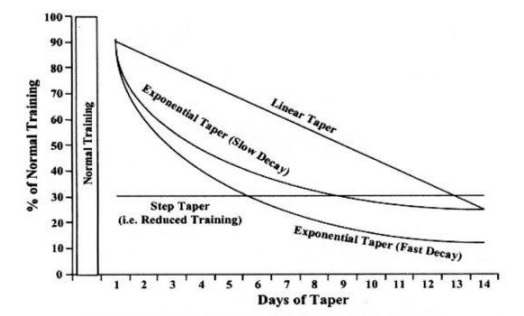
You’ve been putting in the long hours and hard training. Now, your ‘A’ race is looming large on the calendar and with it, the need to taper. Does the thought of a taper cause you to take on a ‘Deer-in-the-Headlights’ look because you’re unsure how to do it? Read on for the answers to all of your taper questions.
What is a taper?
Tapering is the art of decreasing your training load prior to a significant race so that you can perform at your highest level. A taper is about regaining freshness through structured active rest and allowing your body to heal from all of the hard training. Rest is when the body repairs cell and tissue damage, replenishes muscle glycogen, and restores metabolic enzymes. The goal of a taper is to fully recover from the accrued mental and physical fatigue while maximizing physiological adaptations to sharpen your fitness.
How to taper
Recall I said earlier that tapering is an art. One of the unique aspects of a taper is it is HIGHLY individual. What works for one, may or may not work for another and it’s only through analyzing empirical evidence gained from multiple tapers that you will find what works best for you. That said, there are some general guidelines that may be helpful. Here are five-steps that will put you on the path to an effective taper.
Step One – Reduce Volume
There is widespread agreement that the most important aspect of a taper is to reduce volume. There is some disagreement on how and when to reduce volume. However, research support three volume reduction strategies –

Linear – this type of taper involves reducing your training 20% two-weeks out from your race and an additional 20% the week before your race.
Step – a sharp reduction in training load two-weeks before your race and then that volume is maintained until the race. Research has shown this strategy to be the least effective.
Exponential – a reduction in volume that exponentially becomes less as race day approaches.
The length of your taper will be contingent upon your training volume leading up to your race and the specific race you are preparing for. Sprint triathlons are typically a one-week taper. Olympic triathlons are one to two. A Half Iron (70.3) is typically two weeks while a full Iron (140.6) is two to three weeks.
It’s best to have open communication with your coach to determine the best taper duration for you.
Step Two – Maintain Frequency
Don’t reduce the number of workouts you have typically been doing. Particularly in swimming – it’s important to keep your “feel” for the water. To a lesser extent the same is true with running – you want to retain the movements that have been ingrained into muscle memory. To retain efficiency, frequent swim and run training is the best approach.
Reduce the duration of the workouts, not the frequency of the workouts. Strive to maintain your normal workout routine. If you must reduce training frequency during the final week of your taper to accommodate travel to the race, try to limit the reduction to no more than 20%.
Step Three – Maintain Intensity
While reducing volume is important, equally important is retaining intensity in your workouts. Maintaining intensity allows you to minimize any fitness loss during your taper and ensure neuromuscular activation while experiencing fast recovery times because of the reduced volume.
Step Four – Adjust Intervals
You are retaining intensity as you reduce volume, so the structure of your intervals will need to change – decrease the number and duration of intervals while increasing the rest between them.
As an example, if during you’re your triathlon build you would do a 90-minutes cycling workout that included 5 x 12-minutes in high Z4 with 2 minutes recovery between each interval, a modified taper workout would be 3 x 5-minutes in high Z4 with 4-minutes recovery between each interval. If during your mid-season training you were running 10 x 800m at threshold with a 400m jog recovery, change that to 8 x 400m at threshold with an 400m jog to recover.
Step Five – Nutrition/Hydration
During the final week of your taper, you should begin ‘carbo-loading.’ From seven down to four days before your race, you should consume at least five grams of carbohydrate per kilogram of body weight. The final three days before your race eat up to 10 grams per kilogram of body weight.
Also, during the final week, start sipping on a quality sports drink each day – we recommend Infinit Nutrition products.
Final Thoughts
You’re going to have quite a lot of extra time on your hands as you reduce your training volume during the taper. Avoid the temptation to go play a pick-up basketball game or participate in an impromptu soccer match. By the time you get to your taper you’ll have invested a great deal of time, energy and money into preparing for your race. Don’t ruin it within sight of the prize.
Don’t forget to include travel in your taper plans. I have lost count of the number of athletes that have excellent training consistency leading up to their ‘A’ race, then the final week of the taper when they are no longer at home, all the consistency goes out the window and their taper falls apart.
A taper effects different athletes in different ways. Some will feel fresh and ready to go almost from the beginning. Others might feel tired and sluggish a couple of days into the taper. Fear not, stick with the plan and you’ll feel like Superman on race morning! It isn’t uncommon to become anxious and want to test out your new-found freshness. Resist the temptation to push up the intensity during your final workouts.
Congratulations!
After you complete your event you should allow yourself some time off from structured training. If this race was during the season and you have another ‘A’ race later in the season, keep the break to no more than a few days. If this was the final race of your season we strongly advocate at least a 2-3 week break from structured training.
Most importantly, remember why we do this – because it’s FUN!
